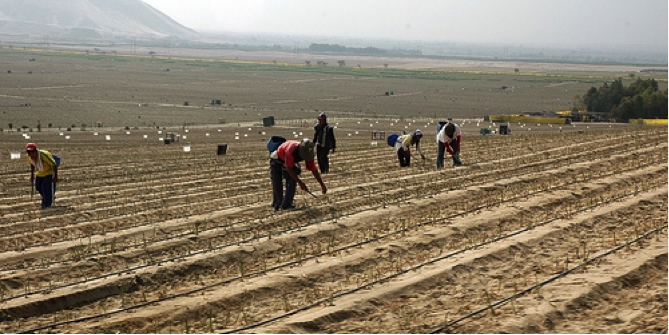National to Global Scale Option 3: Asparagus Production in Peru
Overview
International Production of Asparagus in Peru for the Global Food System
Starting from modest beginnings and export of asparagus from Peru to Denmark in the 1950s, the industrial-scale asparagus sector in Peru’s dry coastal valleys (especially around the city of Ica, Peru) grew rapidly in the 1990s into one of the premier examples of a globalized export vegetable sector (Fig. 1.2.9), able to occupy a large percentage of the world’s off-season market in asparagus when producers in the northern hemisphere are not producing asparagus (FAO 2007). The asparagus sector in Peru takes advantage of the extremely dry climate to make asparagus plants go dormant in the same way that winters in the northern hemisphere make the perennial asparagus plants die back so that they create new edible shoots in the spring. When a field of Peruvian asparagus is ready to go into production, irrigation from rivers and river-fed water tables in coastal valleys is turned on, and a flush of asparagus shoots grows, is harvested using labor that is relatively cheap on a global scale, and immediately flown in refrigerated containers to markets in the rest of the world, chiefly Europe. Asparagus is also notable for being a delicacy among U.S. and European consumers, with a sort of star status among gourmet eaters (see e.g. Peruvian Asparagus) Industrial-scale asparagus producers in Peru were able to achieve this scale of production and access to the global market via support from the Peruvian government, the help of the United States Agency for International Development (USAID), and their own resources and investment, based on earlier successes in the production of cotton in irrigated valleys (FAO, 2007). Interestingly, Ica asparagus growers organized several international tours to learn industrial methods of production in Europe and the U.S. and adapt them to their own region. However, the large scale of production and amounts of water needed are straining water supplies in the Ica region and have prompted objections regarding water supplies for other uses and the environment. Further, expansion of irrigation in Ica has been based on dam-building in upriver sites which alters ecosystems and water rights for other farmers in these valleys. The abundant supply of migrant labor from the Peruvian highlands and the economic power of the growers has also led to labor relations that are often quite unfavorable to workers.

Readings
Before drawing your concept map and filling in the table information for this assignment make sure to read the following news piece about Peruvian Asparagus from to learn more about the Peruvian asparagus industry and concerns about fresh water supply: Peru water wars threaten export boom.
You may also want to consult this brief from an industry news site covering the global fresh fruit and vegetable trade, detailing how asparagus is the most common Peruvian product shipped by air: Peru: Asparagus is the most exported product by air
Optional Reading
Diaz, Luz Rios. 2007. Agro-industries characterization and appraisal: Asparagus in Peru. Rome: FAO, 56 p.
